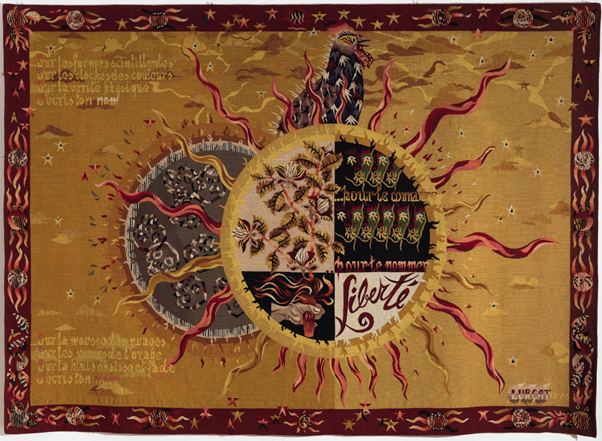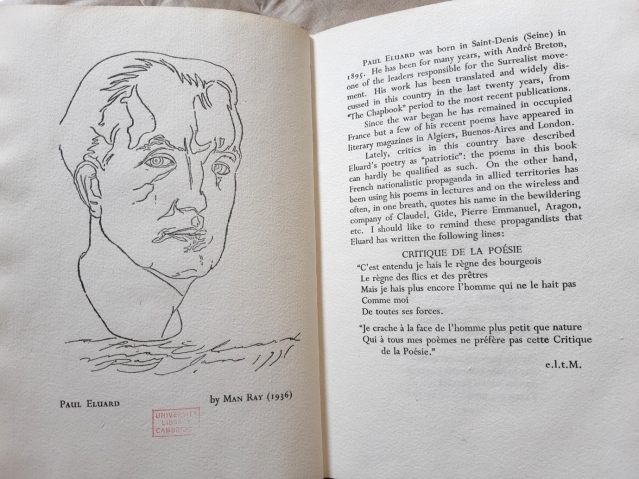The police killing of 17-year-old Nahel Merzouk on 27 June in Nanterre (in the suburbs of Paris) and civil unrest that occurred subsequently in France show how challenging it is to uphold the values of equality and fraternity, both socially and institutionally. For Bastille Day this 14th of July, we focus on the famous poem ‘Liberté’, initially entitled ‘Une seule pensée’, composed by Charles Eluard under the German occupation of France in 1941. This love poem to Nusch was turned into a celebration of and aspiration to Freedom. It is marked by the leitmotiv “J’écris ton nom”, reminding us of the power of both speech and writing. While the collaborationist Vichy régime had replaced the French revolutionary motto from “Liberté, Egalité, Fraternité” to the conservative “Travail, Famille, Patrie”, the poem “Liberté” became emblematic of French resilience throughout the Second World War and beyond. This blogpost gives an overview of the early publications of the poem: many of which are available at Cambridge University Library, including special editions with the Eluard’s signature and dedications, within the Chadwyck-Healey Liberation collection.
The poem first appeared in June 1942 as ‘Une seule pensée’ in the Algiers-based journal Fontaine [Retronews], revue mensuelle de la poésie et des lettres française, to evade the Vichy censorship and allow its dissemination in the Free Zone. In September 1942, it was also published in London by the Gaullist magazine La France Libre: liberté, égalité, fraternité (LSF). ‘Liberté’ was published by the surrealist Parisian collective La Main à Plume in the collection Poésie et vérité 1942 [Gallica] (named after Goethe’s autobiography) at the end of September of this year, although on the publication itself, it was dated 3 April 1942, to evade the new censorship laws of April 1942.
‘Liberté’ featured in La Revue du monde libre [Gallica], published in London, in April 1943, under the title ‘Une seule pensée’. Thousands of copies of the poem were dropped by parachute by the Royal Air Force, together with arms shipments. The poem appeared again in Poésie et Vérité 1942 in February 1943 in the Cahiers du Rhône (Éditions de la Baconnière, Neuchâtel, Switzerland). On 19 December 1943, it was published in France Amérique [Retronews] (New York).

1943 was a year when the poem was adapted in different artistic media. ‘Liberté’ inspired the artist Jean Lurçat (1892-1966) for a large clandestine tapestry featuring the poem with two large suns including heraldic and symbolic motives relating to France and to the war.
Also in 1943, Francis Poulenc (to whom Eluard sent typed poems under various pseudonyms), composed Figure Humaine: cantate pour double chœur mixte à cappella, published by Paul Rouart with an English translation by Rollo Myers (MRS.8.3233). It was sent to London where it was first created in English by the BBC in 1945, then in French in Brussels in 1946 and in Paris in 1947.
‘Liberté’ kept being reprinted and features in the collection Dignes de vivre by Eluard, unassumingly illustrated with small line portraits by Jean Fautrier, published by the Éditions litteraires de Monaco and René Julliard in 1944 (Liberation.c.49).
Cambridge UL holds the bilingual edition, Poésie et vérité 1942 (Poetry and truth 1942), published by London Gallery Editions in 1944 (9735.d.256), translated by Roland Penrose & E.L.T. Mesens (and signed by them), with a portrait of Eluard by Man Ray.
‘Liberté’ also featured in L’Honneur des poètes — Choix de poèmes de la Résistance française, published in Rio de Janeiro by Atlantica Editora on 14 July 1944, and the poem appeared in the Liberation issue of the Etoiles du Quercy, a Communist resistant journal published in Cahors in Août-Septembre 1944.
The year 1945 saw a flurry of reprints and new editions: the poem was published in Cahors by the Éditions des Francs-tireurs partisans français du Lot, then as a special issue of Fontaine, entitled Conscience de la France, published in Rio de Janeiro, Brasil.
It was also published in Paris by Éditions GLM (see Gallica and Liberation.b.97). The same year, Poésie et vérité 1942, starting with ‘Liberté’ was published along with Au Rendez-vous allemand, by the Éditions de Minuit (Liberation.c.292). Our copy of this book, illustrated by Picasso, is inscribed by Eluard to Georgette Berger and René Magritte.
Poésie et vérité 1942 [Gallica] was also published in Algers in 1945 by the Éditions de la revue “Fontaine”, as well as in Brussels by Éditions Lumière, including “16 dessins au pinceau de Franz Sébastien” (Liberation.c.25). Cambridge University Library’s copy is signed by Éluard and inscribed to his friends the writer Jean Marcenac and his wife Andrée Labry. ‘Liberté’ was reprinted in La France libre. Numéro anthologique : novembre 1940 – septembre 1945, published in Paris in 1946 (Liberation.b.278).
In the post-war period, one of the most famous and striking editions of the poem is that published in 1953 in concertina form and illustrated by Fernand Léger using the pochoir technique. It contains a portrait of Eluard after a painting made by Léger in 1947. The limited edition was produced at the request of the poet, resistant, and publisher Pierre Seghers, after the death of Eluard in 1952. Cambridge UL holds a facsimile produced in 2016, after the artwork was displayed on the Centre Pompidou façade in Paris, following the terrorist attacks of 13 November 2015 (S950.a.201.5263).

Irene Fabry-Tehranchi
References:
- Louis Parrot, L’intelligence en guerre : panorama de la pensée française dans la clandestinité, Paris: La Jeune Parque, [1945] (S735.d.94.27 and Liberation.c.957), p. 111.
- Paul Éluard, Œuvres complètes, ed. Lucien Scheler et Marcelle Dumas, Paris: Gallimard, 1968, (S735.d.96.131-132) vol. 1, p. 1606-1607.
- Elsa Mourgues, “Liberté”, le poème d’amour devenu hymne de la Résistance, France Culture, 2022.













